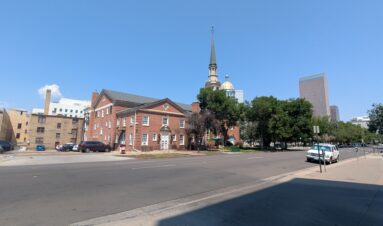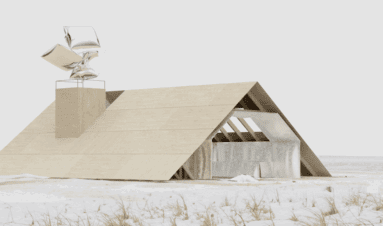First Church of Christ, Scientist
1401 Logan Street
Fast Facts
Architect: Ernest Phillip Varian Lester Varian & Frederick J. Sterner
Architectural Style: Greek Revival
Year Built: 1904
Designation: Denver Landmark
Neighborhood: Capitol Hill
Handicap Accessible
No Food or Drink
First Church of Christ, Scientist
The First Church of Christ, Scientist, is an elegant classical gray stone building located at the corner of Logan and 14th Streets. It was designed by Ernest Phillip Varian of Varian and Sterner in 1904. The building is an unusually pure example of the Greek Revival style of architecture and has detailing that is reminiscent of ancient Greek temple architecture.
The main entry to the building on Logan Street features a large portico with a triangular pediment atop six massive stone columns with ionic capitals. “The Eternal God Is Thy Refuge” is incised along the frieze below the pediment. The building is square in plan, with each side stretching 125 feet. The design is capped with a segmented copper-clad dome. Inside, the layout of the sanctuary is inspired by the design of ancient Greek theaters. The floor is sloped and the seating is arranged in semicircles focusing on the central podium where the First Reader (a lay minister) reads the scripture passages for the church service. The sloped floor allows each congregant to have a clear view of the podium. The sanctuary has individual stadium seats instead of traditional pews. When it was built, the sanctuary had the largest open unobstructed auditorium in the city and held 1,800 people. Deep steel beams cross the ceiling and are capable of holding the roof up without additional columns. The architect specified quarter-sawn Russian oak for the wood trim throughout the building. Russian oak has finer grain and is denser than American red oak.
Classical architecture became popular in America after the 1893 Columbian World’s Exposition in Chicago, which launched the City Beautiful movement. One of the primary concepts of the movement was that beauty had the capacity to inspire human thought and behavior, encouraging civic loyalty and harmonious urban moral order. The idea of elevating thought through architecture was very appealing to church leaders and many early Christian Science churches were built in classical styles.
The building at 1401 Logan was built to replace an earlier Christian Science church, which sat three blocks north at 1751 Logan. The original church was built in 1891. At the end of the 19th century Christian Science was the fastest growing religion in America. By 1899, only eight years after the first church was built, the congregation realized that they needed to build a new church to accommodate their growing numbers. At the time it was built, the church at 1401 Logan was the largest Christian Science church west of the Mississippi.
The First Church of Christ, Scientist was the first large structure in Capitol Hill built of lava stone, which was produced by the Kerr Quarry in the Arkansas River Valley near Salida, Colorado. The cornerstone of the building is made from granite quarried in New Hampshire, the home state of Mary Baker Eddy, the founder of the Christian Science church.
References
First Church of Christ Scientist, Denver Fact Sheet.
Grinstead, L. (2002). Molly Brown’s Capitol Hill Neighborhood. Denver, Colorado: Historic Denver, Inc.
Murphy, J. (1995). Geology Tour of Denver’s Buildings and Monuments. Denver, Colorado: Historic Denver,Inc.
Noel, T.and Norgren, B. (1993). Denver: The City Beautiful. Denver, Colorado: Historic Denver, Inc.
Map
First Church of Christ, Scientist
1401 Logan Street, Denver, CO, USA
Nearby Sites
View All
First Baptist Church of Denver
First Baptist Church of Denver First Baptist Church of Denver was organized prior to Colorado's ...
More Info
Denver Woman’s Press Club
The Denver Woman’s Press Club (DWPC) clubhouse, known as the Burr House, was built in 1910 in the...
More Info